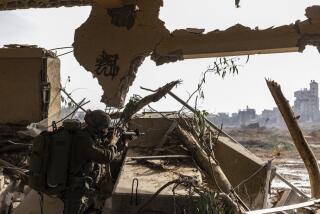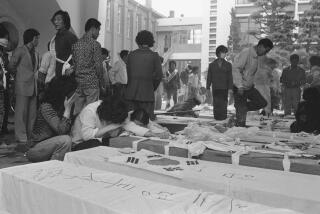Past Torments Present as Berlin Honors War Dead : Germany: WWII memorial, also dedicated to victims of tyranny, is inaugurated. It has evoked ‘hysterical’ debate.
To the boos and catcalls of protesters, German leaders Sunday inaugurated a controversial national memorial labeled “To the victims of war and tyranny”--the first such monument in Germany since World War II.
In a brief ceremony conducted in sleet and icy winds, Chancellor Helmut Kohl and President Richard von Weizsaecker led a small group of dignitaries in wreath-laying ceremonies formally opening the memorial on the capital’s prestigious Unter den Linden.
There was a heavy police presence around the ceremony, and the memorial was not opened to the public immediately afterward as planned because of security concerns.
Eight people were arrested after scuffles between security officers and demonstrators.
While the memorial’s centerpiece--an enlarged bronze version of a Kaethe Kollwitz sculpture titled “Mother With Dead Son”--is an acclaimed work by a respected German artist, just about everything about the memorial has been subjected to bitter, prolonged debate.
Kohl, personally involved in selecting both the site and its content, wanted a place that would allow Germans to mourn their war dead as other nations do without offending the victims of Germany’s aggression.
In a statement issued Friday, Kohl called the memorial “an important symbol of a reunited Germany and the dignity, value and the rights of the individual set out . . . in the democratic constitution.”
In many ways, the idea reflects the chancellor’s desire to make modern Germany a “normal” country, with the patriotic symbols that are taken for granted in most democracies.
But both Sunday’s inauguration and the debate leading up to it only underscored a painful reality: Unified Germany remains tormented and emotionally crippled by its history.
“Is it possible to think of another nation that would discuss the design of a memorial so hysterically?” playwright Rolf Hochhuth asked in an extensive criticism of the memorial printed in Saturday’s editions of the Berliner Morgenpost.
A key target of Sunday’s protests was the inscription at the base of the sculpture--”To the victims of war and tyranny.” It is a straightforward dedication in most countries, but not in Germany.
Critics argued that the words lump Nazism’s victims together with its perpetrators.
“German Culprits Are Not Victims,” read one protest banner at Sunday’s ceremony.
Other protesters shouted, “Nazis out!”
After months of talks with leaders of Germany’s Jewish community and other groups persecuted by the Nazis, two metal tablets were placed on an outer facade of the building housing the memorial, one of which lists specific groups of Nazism’s victims, including “the millions of murdered Jews.”
While that compromise was enough for the head of the Central Council of Jews in Germany, Ignatz Bubis, to attend Sunday’s inauguration, others rejected the move.
“You can’t just remember millions of murdered people in half a sentence,” said Jerzy Kanal, chairman of the Jewish Community in Berlin, who boycotted the ceremonies. “We can’t accept this memorial.”
Aside from the inscription, the choice of the building itself, the Neue Wache, is hotly disputed.
Designed in the early 1800s, the Neue Wache was used as an imperial guardhouse for a century before it was eventually converted into a World War I memorial in 1931 during the final years of the ill-fated Weimar Republic.
But mainly because Adolf Hitler seized it as the focal point of the Third Reich’s annual “heroes’ memorial day” and the Communist East Germans followed in the 1960s, claiming it an important monument and posting goose-stepping guards outside, many believed it was totally inappropriate for a modern democratic Germany.
Even the idea to enlarge the sculpture has been controversial, with many saying that the piece of art Kollwitz created barely 15 inches high cannot just be made bigger to fit its surroundings.
Kollwitz, who lost her 18-year-old son in World War I, sculpted the piece in 1937, eight years before her own death.
Elsewhere in Germany on Sunday, security forces arrested more than 140 right-wing extremists who tried to defy a ban and rally south of Berlin at the site of one of World War II’s last big battles, the Associated Press reported.
In one of the largest efforts ever launched against the radical right, at least 2,000 police were deployed along autobahns in five states to keep neo-Nazis from rallying in Halbe, 25 miles south of Berlin.
More to Read
Start your day right
Sign up for Essential California for news, features and recommendations from the L.A. Times and beyond in your inbox six days a week.
You may occasionally receive promotional content from the Los Angeles Times.






